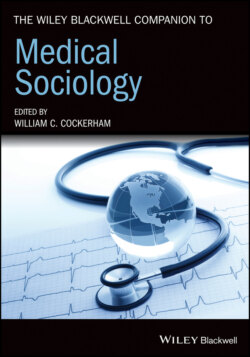Читать книгу The Wiley Blackwell Companion to Medical Sociology - Группа авторов - Страница 83
Bio-value and Virtual Bodies
ОглавлениеWhilst the above discussion has highlighted the body as an unfinished and malleable entity which has become central to the formation of the late modern reflexive self, other postmodern analyses have suggested that the body is not so much uncertain as un/hyperreal. In other words, the body has disappeared – there is no distinction between bodies and the images of bodies. Drawing on the work of Baudrillard, Frank (1992) challenges the conventional idea that the body of the patient forms the basis of medical practice. It is the image of the body which now forms the basis of medical care.
Real diagnostic work takes place away from the patient; bedside is secondary to screen side. For diagnostic and even treatment purposes, the image on the screen becomes the “true” patient, of which the bedridden body is an imperfect replicant, less worthy of attention. In the screens’ simulations our initial certainty of the real (the body) becomes lost in hyperreal images that are better than the real body. (Frank 1992: 83)
The “Visible Human Project” (VHP), described on the US National Library of Medicine, National Institutes of Health website as:
the creation of complete, anatomically detailed, three-dimensional representations of the normal male and female human bodies. Acquisition of transverse CT, MR and cryosection images of representative male and female cadavers has been completed. The male was sectioned at one millimeter intervals, the female at one-third of a millimeter intervals. (National Library of Medicine 2008)
Fascinated by this undertaking, Catherine Waldby (2000) subjects the VHP to sociological scrutiny and highlights some intriguing features. Not only do images of the inner reaches of the body become accessible to a wide audience, but also the transformation of bodies into a “digital substance” contributes to the blurring of boundaries between the real and the unreal, the private and the public, and the dead and the living (Waldby 2000: 6). She argues that the whole exercise represents a further extension of Foucault’s notion of bio-power. The VHP is at once a means of both examining and experimenting on the body and, therefore, it is also a means by which knowledge of bodies is generated and circulated.
In addition, the establishment of knowledge contributes to the production of “surplus value” in that there are significant commercial interests that benefit through the related production of medical technologies be they equipment, drugs, and so on. This is what Waldby calls “biovalue,” which refers to the yield of vitality produced by the biotechnological reformulation of living processes” (Waldby 2002: 310). Two factors precipitate the generation of biovalue. First, the hope that biotechnologies will result in a better understanding and thereby treatment of disease. Second, the pursuit of exchange value of biomedical commodities – be they patents or pills – that are the yield of the interventions. Indeed, biovalue is “increasingly assimilated into capital value, and configured according to the demands of commercial economies” (Waldby 2000: 34).
The counterpart to the VHP, observes Waldby, is the Human Genome Project (HGP) in that both projects are means by which the body comes to form a database, an archive and so a source of bioinformation. The digitization of bodies however further complicates the dualism between virtual and real bodies presumed in the work of Frank and Waldby. The infiltration of the bodies of the relatively mobile and relatively wealthy by smart, wearable biosensor technologies creates further scope for biovalue and commodification of bodies as evidenced through on-line platforms that harvest biodata, such as 23andMe and other genetic testing organizations (Saukko 2018).
Historically, perhaps one of the most profound impacts of the production of images is in relation to pregnancy. Barbera Duden (1993) argues that the use of technologies which enable the fetus to be visually represented has contributed to the transformation of an unborn fetus into a life. The imagining of the unborn has meant that the fetus has become an emblem, a “billboard image.” Her study addresses the following puzzles: How did the female peritoneum acquire transparency? What set of circumstances made the skinning of women acceptable and inspired public concern for what happens in her innards? And pertinently: how was it possible to mobilize so many women as uncomplaining agents of this skinning and as willing? (Duden 1993: 7). In an amazingly short space of time, “the scan” became a routine and ubiquitous experience for most pregnant women in many Western societies. This prompts tensions between the way the body is experienced or lived and the way the body is observed and described by “medical experts” (Dumit 2010). This tension is explored empirically by Lie and her colleagues (2019) in their study of parents’ experiences of an in-utero MRI (iuMRI) device that has been developed to increase accuracy of diagnosis of foetal brain abnormalities, it is not therefore used routinely but accessed in addition to ultrasound anomaly scanning. From their analysis of the parents experiences they conclude that while, the “‘medical’ gaze may work to separate the foetal body from its social identity” by contrast “the ‘parental’ gaze often does the opposite, reconstructing or reinforcing foetal and parental identities” (p. 376). Thus the lived experiential, embodied view of the body is retained even in instances where it becomes reduced to representation in a digitized form.
